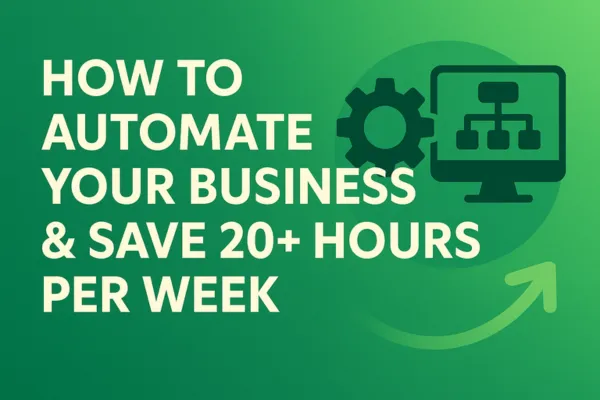
How to Automate Your Business and Save 20+ Hours a Week | BuildBetr
How To Automate Your Business and Free Up 20+ Hours a Week!
Introduction:
Running a business can feel like a never-ending to-do list. Emails, follow-ups, customer management, marketing... it never stops.
But what if you could automate 70% of it — and finally have time to actually grow your business?
In this blog, you’ll learn a simple, step-by-step way to start automating your business without needing to be a tech expert.
📋 What You’ll Learn:
Why automation matters for small business owners
The core systems every business should automate first
A simple 5-step plan to start today
Common mistakes to avoid with automation
Real-world examples you can model
Why Automation Matters for Small Business Owners
When you're doing everything yourself, your growth is capped.
You can’t scale if you're stuck sending every email, scheduling every call, or chasing every lead manually.
Automation frees you up to focus on what actually grows your business:
Building better offers
Closing bigger deals
Strengthening your brand
Serving your best customers at a higher level
Without automation, you’re trapped. With automation, you scale.
The Core Systems Every Business Should Automate First
Here are the first areas you should automate immediately:
📧 1. Lead Capture and Follow-Up
Automatically collect leads from your website, funnels, and ads
Trigger immediate email + SMS follow-ups
Book appointments without manual back-and-forth
🛒 2. Sales Pipelines
Create a simple pipeline that moves leads from "New" to "Closed" without manual tracking
Get reminders automatically for who to call, text, or email next
📅 3. Appointment Scheduling
Use an automated calendar link (like in BuildBetr) so leads can book on your schedule
No more “what time works for you?” email chains
💬 4. Customer Communications
Automated email and SMS campaigns that keep customers engaged and buying more
Post-purchase sequences, review requests, upsell offers
💵 5. Payments and Invoicing
Automatically send invoices, collect payments, and issue receipts
How To Start Automating Your Business (Step-by-Step)
🔥 Step 1: Map Your Customer Journey
Write out the steps a customer goes through — from first seeing you to paying you.
Example:
Ad → Funnel → Form → Appointment → Sale → Follow-up
Knowing this helps you see where automation fits naturally.
🔥 Step 2: Choose Your Core Automations
Pick just 2–3 areas to automate first (lead capture, follow-up, and booking are the highest leverage).
Don’t try to automate everything on Day 1. Start simple.
🔥 Step 3: Set Up Basic Workflows
Use a system like BuildBetr to:
Trigger a welcome email immediately after a lead opts in
Send appointment reminders 24 hours and 1 hour before meetings
Move contacts automatically between pipeline stages based on actions
🔥 Step 4: Test and Improve
Always test your automations by acting like a customer.
Fill out your forms, book your calendar, reply to emails — and fix any gaps before launching live.
🔥 Step 5: Expand Automation as You Grow
Once your basics are running smooth, expand into:
Post-sale automations (like reviews or upsells)
Win-back campaigns (for old customers)
Referral campaigns (to get customer referrals automatically)
Bonus Tips: Common Automation Mistakes to Avoid
Trying to automate too much too fast.
Start small, build momentum.Forgetting the human touch.
Automations should feel personal — customize names, messages, and timing.Ignoring metrics.
Track open rates, click rates, and bookings. Fix what doesn’t work.Setting it and forgetting it.
Review automations every 30–60 days. Businesses change — your automations should too.
Real-World Example: “How One Store Owner Got 15 Hours Back Per Week”
One store owner we worked with was manually emailing every lead, scheduling calls, sending invoices, and chasing follow-ups.
After installing three simple automations:
Lead form to automated follow-up
Auto appointment scheduling
Auto invoice + receipt system
They freed up 15–20 hours per week and increased their monthly revenue by 32% within 90 days — just by focusing more on high-ticket sales instead of busywork.
Conclusion
You don't have to do it all yourself anymore.
Start small with automation. Focus on just 2–3 key areas first.
Then, as the systems run, you'll have more time, energy, and freedom to actually grow your business instead of being trapped inside it.
Automation isn’t just a tool — it's a scale accelerator.
✅ Ready to Automate Smarter?
If you want a simple way to automate your sales, marketing, and operations — without the tech headaches — Let’s jump on a call and get you started!
Grab the best day & time that works for you below:
👉 Book a 1on1 Free Strategy Call with me Here!
Let’s build a business that works for you — not the other way around.
Want to contact us? Email: [email protected] | Phone: 615-861-9854
